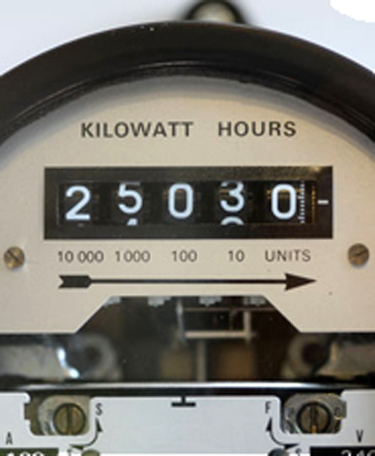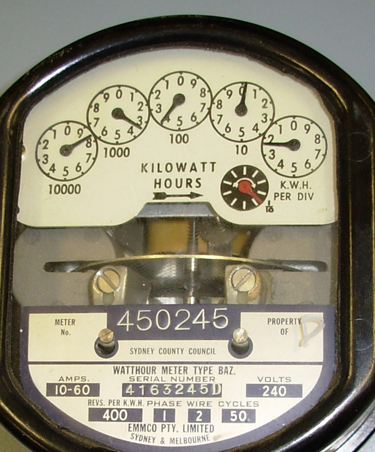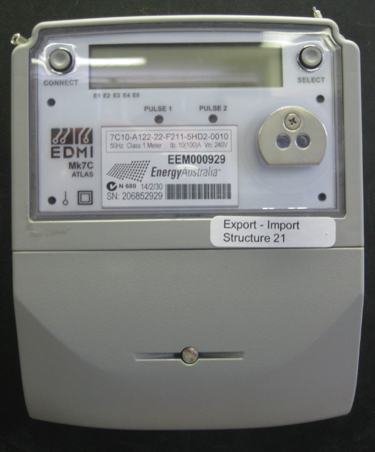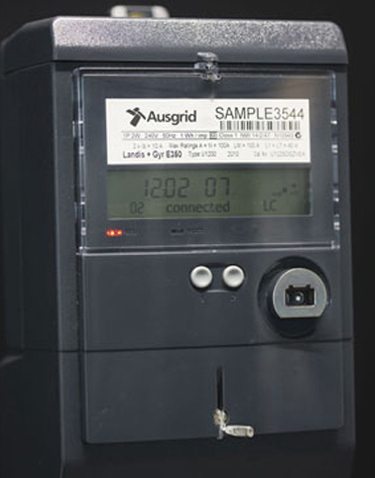Ausgrid owns most meters connected to our network. We are responsible for reading your meter and sending the data to your electricity retailer. There are typically three different types of meters. You can find the meter dimensions listed below. Unfortunately we cannot provide dimensions for older models installed before 2004 due to the existence of a significant number of legacy models.
Accumulation meters
Accumulation meters only keep track of the total electricity usage. This means you are charged the same amount for the electricity you use, regardless of when you use it. For this reason these meters are also known as flat rate meters.
Accumulation meters can be electronic or electro-mechanical. Electronic accumulation meters have a digital display. Electro-mechanical accumulation meters have two different types of displays – a dial display or a cyclometer display.
The meter reader will sight the meter and type it in to their handheld computer that sends the data directly to our systems. The reading is then validated and sent to your electricity retailer who calculates your final bill.
Meter dimensions
| Meter name | Meter type | Dimensions (mm) |
| AMS (L+G EM500) B1 Meter | Accumulation | 132 (W) x 152 (H) x 51 (D) |
| HLA Holley (Formway) DDS-28B B1 Meter | Accumulation | 130 (W) x 141 (H) x 49 (D) |
| AMT L&G EM3030 B3 Meter | Accumulation | 241 (H) x 165 (W) x 104 (D) |
| HLE Holley (Formway) DTS541 B3 Meter | Accumulation |
255 (H) x 170 (W) x 63 (D) OR 273 (H) x 170 (W) x 63 (D) with an optional external hook |
Cyclometer display

Dial display

Electronic display

Interval meters
Interval meters record how much electricity is used every 30 minutes. This means you can have different electricity rates for usage at different times of the day, depending on the tariff you sign up to with your electricity retailer. Some of the benefits of interval meters include more detailed information on your energy use and the opportunity for pricing plans that provide incentives to reduce your demand for electricity during peak times. For this reason, these meters are also known as time-of-use meters. Learn more about time-of-use tariffs.
Interval meters are all electronic. The display of the interval meter is programmed to show the date and time (in Eastern Standard Time as required by the National Electricity Rules) as well as the total kilowatt hours (kWh).
To read an interval meter the meter reader attaches an optical probe to the meter and downloads the 30-minute interval data into a handheld computer. That information is then sent to our systems, validated and then sent to your electricity retailer so they can calculate your bill.
Meter dimensions
| Meter name | Meter type | Dimensions (mm) |
| L&G AMG EM1000 Electronic Meter | Interval | 130 (W) x 125 (H) x 50 (D) |
| PRS PRI I – Credit 400 Electronic Meter | Interval | 144 (W) x 242 (H) x 88 (D) |
| EEL EDMI Mk7C E1 Meter | Interval | 134 (W) x 164 (Height with standard terminal cover) x 59 (D) |
| PRT PRI I-credit 400 Electronic Meter | Interval | 144 (W) x 242 (H) x 88 (D) |
| AMJ (L+G) EM1210 E2 Meter | Interval | 140 (W) x 227 (H) x 74 (D) |
| EET EDMI Mk10A E3 Meter | Interval | 166 (W) x 210 (Height with standard terminal cover) x 74 (D) 166 (W) x 240 (Height with extended terminal cover) x 74 (D) |
| PRI-Sprint Whole Current PRW Electronic Meter | Interval | 175 (W) x 250 (H) x 66.7 (D) |
| AMX and AMZ L&G EM5100 Electronic Meter | Interval | 172.7 (W) x 236.5 (H) x 78 (D) |
| LGC L&G U3300 E3 Wimax Meter | Interval | 175 (W) x 229 (H) x 109 (D) |
Type E1 (single phase)

Type E2 (single phase dual element)

Type E3 (three phase)

Smart meters
New smart meters are supplied and installed by your retailers appointed provider, any questions surrounding your smart meter should be directed to your retailer. Smart meters are remotely read by your retailers appointed metering data provider, these meters record your energy in the same way as interval meters, that is, recording how much electricity is used every 30 minutes. This means you can have time of use pricing.
For information regarding the other functions and services provided by smart meters, please contact your retailer.
From 1 December 2017, any new or replacement meters for homes or small businesses will be smart meters, installed by your electricity retailers appointed provider, not Ausgrid. Learn more about this change.
Meter dimensions
| Meter name | Meter type | Dimensions (mm) |
| ECA EDMI Mk7C E1c Meter |
Interval | 134 (W) x 214 (H) x 70 (D) |
| ECJ EDMI Mk7A E2c Meter | Interval |
128 (W) x 212 (H) x 111 (D) |
| ECP EDMI Mk10D E3c Meter | Interval | 175 (W) x 292 (H) x 95 (D) |
Two types of smart meter



